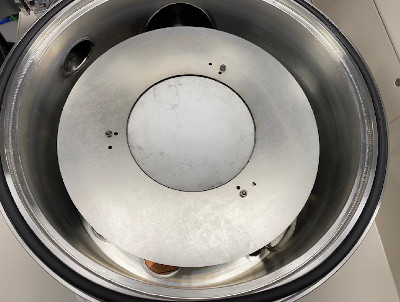
This is a much condensed manual made from the manufacturers manual.
This document is intended as a help to users already familiar with the system. All users of this system MUST have hands on training with an experienced user, preferrably a Nanolab manager.
The system should be powered on and pumping at all times. The chamber should be under vacuum, at around 5 × 10-7 mbar. If it is not, please call a lab manager or an experienced user for help.
To insert a substrate, the chamber must first be ventilated.
On the touch screen navigate to "Main Menu" and press
"Vent
Chamber".
The turbo pump is shut off, the system waits for the pump rotor
speed
to decrease. When the speed is sufficiently low, the rough pump
is stopped and venting gas is passed into the chamber.
The status display on the "Main Menu" shows
"Venting...".
When the venting is complete and the chamber is at atmosphere,
the status shows "Vented".
Wait for ventilation to finish. Open the chamber door by lifting the extended piece at the front. Move the door all the way to the back so it rests on the hinges and stays there by itself.
Do not force the door before the venting is finished!

Warning: never touch any part or surfaces of the substrate heating stage assembly! They may be extremely hot! This may also apply to other in-chamber surfaces after substrate heating has been carried out.
Carefully close the door.
Press "Pump Chamber" on the "Main Menu".
The chamber is first pumped by the roughing pump. When the
pressure has dropped below the "door" pressure
setpoint and additional 30 seconds, the turbo pump is started.
When the pressure has dropped to 5 × 10-5 mbar,
the chamber is ready for heating and inlet of process gases.
Warning! Make sure the door is closed prior to start
pumping. To pump a non-sealed chamber could cause damage to the
system (turbo pump).
Before running a process (automatic or manual) you should check if there are any previous errors that need to be cleared in the "Diagnostics Menu"
The system is operated according to a predefined process (recipe). Each process can consist of multiple stages.
In order to run a predefined process, navigate to the "Process Selection" screen and select the process to be run.
Then enter "Process Execution" screen and press
"Process Start"
While the process is running, the "Process Execution"
screen
displays a variety of information relating to system
conditions. In addition, the "Plots" screen provides a
summary of
conditions in a graphical format.
It is possible to skip to the next stage and hold at the
hardware settings defined for the current stage. A running
process will be terminated when the system moves into a stage
that has zero values for stage time and heater stage
temperature.
It is also possible to manually terminate a running process at
any time using the "Process Stop" button on the
"Process Execution" screen.
When the process ends, the system goes to standby, pumped state.
In case an error occurs during the run, a dialog box will be displayed on the "Process Execution" and "Plots" screens to warn the user. For some errors, a running process will be immediately terminated. Detailed error information is available via the "System Log" and "Diagnostics" screens.
The system is equipped with Automatic Pressure Control (APC). For certain combinations of gas flow and pressure the APC can work suboptimal. It is possible to check wether a flow/pressure combination is allowed by the system: goto "Manual Control" screen, "Gas/Pressure Control" section, enter MFC flow rate and setpoint pressure, engage "Pressure Control".
If the system shows that this pressure cannot be achieved, it is possible to adjust a throttle valve between the turbo pump and the chamber. This MUST be done by a qualified person, lab manager.
If the performance of the APC is poor, e.g. slow to achieve setpoint pressaure, oscillations, the feedback loop can be tuned. This should also be done by a qualified person, lab manager.
The ability of the APC to achieve setpoint pressure is dependent on wether the setpoint for flowrate is near the maximum or minimum flowrate of the MFC:s.
Example: If you set a ratio of N2/O2 to 50/1, there could be a problem for the APC to reduce/increase the flowrates to achieve the desired total (setpoint) pressure.
The maximum flowrate for the MFC:s is 50 sccm, and initial tests have shown that a flowrate of 1 sccm is minimum for a reliable operation of the APC.
The APC will adjust the gas inlet flows to achieve the desired pressure if necessary, but will try to keep the gas flow ratio constant (50/1).
Manual operation is useful for initial process development. Once a set of conditions has been established for annealing a particular substrate, these can be packaged into a recipe (process) for automatic operation (as above).
Warning! Using high gas pressures (about 8×10-2 mbar or higher), when using high gas flowrates (e.g. 50 + 50 sccm) will increase the heat conductivity inside the chamber, thus heating up the outer walls. Care should be taken when using high temperatures in combination with high gas pressures.
Warning! When using oxygen the heating element is considered to be a consumable, i.e. it degrades much faster than when using other gases due to oxidation.
Please discuss with the Nanolab staff before using an oxygen annealing process!
Close the chamber door.
The system should always be left in pumped down state after a user finished their process!
Write down date, user name, process conditions, substrates, materials in the Log Book.
Each stage can have a name, and parameters that can be set are: